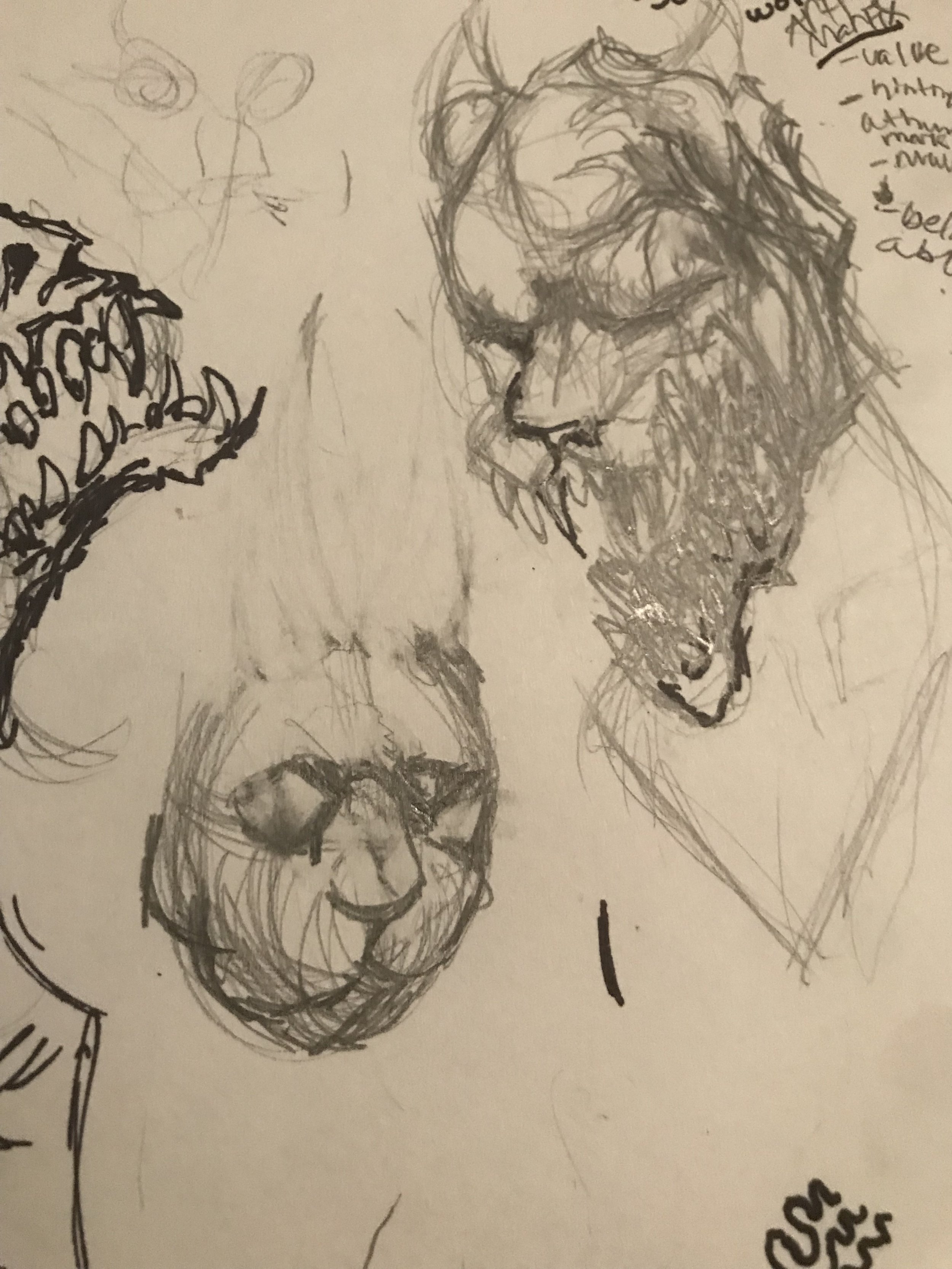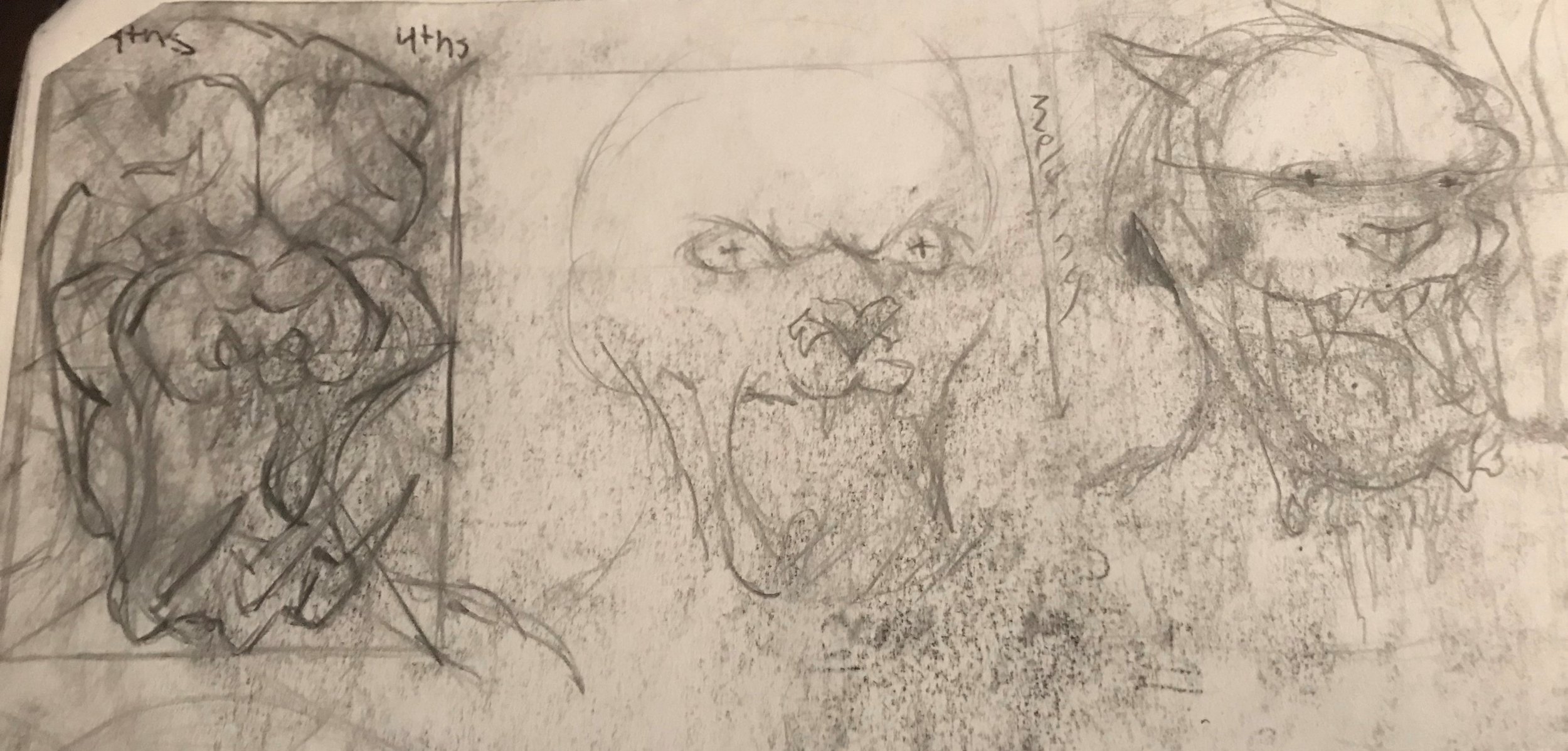It may be compelling to jump into a piece. When the inspiration strikes you want to start right away! This may work for some pieces, but sometimes you sit there at your table, canvas, computer etc, and you find yourself unsure of what to do. Even if you finish the piece, there are things you wish you would have done instead, this is where sketching comes in. Sketching has been an important part of art ever since the Renaissance. Leonardo da Vinci was known to sketch as a means of learning more about a subject matter and then later use these sketches to combine his knowledge into his final piece. For example, he would sketch the hands of people he met on the street frequently. When he went to the final he not only had an image of hands that he wanted to use but he also knew the anatomy of the hands by instinct. In the same way, I try to learn more about a subject matter through sketching.
A piece I did in 2015 raised some problems. I wanted to create a scary looking monster that looked like his face was melting off, and the creature was a visual hybrid between wolf and human. I had no means of knowing what this creature would look like based on memory because they (thankfully) don’t exist. But here’s the magic trick that artists use, sketching and combining sources. To explore this magic I'm going to walk you through the process of how I designed “Scream” (2015).
The first step actually happened a year before the final piece. Concepts in my head of this creature screaming in pain and some sort of combination of a wolf and human appeared and I knew I had to remember this. I did some quick ink sketches and did not think much of it. As you can see these sketches are just to get the very basic idea down, almost as if it's to record the idea before the memory is gone. This is my first advice to you and probably the biggest advice I would ever give to anyone, always have a sketchbook! At very least keep a notebook with you to take detailed notes, this could even be your phone. But I encourage you if you want to do anything relating to art, have a sketchbook.
After you have your initial idea take a moment to arrange the objects in your piece. This can be quite simply by doing 3 to 5 drawings of just placing your character in a box. This box will be the edges of your composition. More complexly you can use rhythmic design. Rhythmic design is the process of using geometry to divide up your composition in meaningful and aesthetically pleasing ways. For such designs, you will need an understanding of the golden section. Which I will talk about in a future post. But for now, know that dividing your composition into ‘thirds’ will create something aesthetically pleasing.
The next step is adding your details and building your final sketch. Build your final from your many sketches. If you are stuck with a pose, texture or anything else, sketch some more! This will be your final sketch. In digital art, this will be his final sketch that you would use to line over. If you're inking in any sort of way the same thing applies.
If your piece has value (black and white) the next step are value sketches. Value sketches may not seem that important, but value can make or break a piece. Let me tell you how bad my value understanding was in my early high school years when you couldn't understand what my piece was trying to be! It was unrecognizable. You can make wondrous creatures of all types and really put the viewer through a lot of mental loops, but if you don't have the value settled then your peace will be significantly less readable. Value works on a one-to-ten scale, one being the lightest (white) and 10 being the darkest (black). If this is your first time working with value, you should create a value scale. Value scale is when you take any medium of your choice (probably your favorite) and you try to get from the lightest value on the left to the darkest value to the right. From one to another you start with white, then to a slight grey and so on and so forth until you reach black. In the same way, you want to create a composition that has all the necessary values for your piece to be readable. Once you created your value sketch you're good to move on to color.
Color is a difficult concept to grasp. There's a lot of theories that play into how colors affect the viewer, however, I'm just going to tell you to picks the colors that match your values. For example, if you have a dark value, say a number 9, you're not going to pick a yellow to represent that value. Now, yellows can be dark but you're most likely not going to find a 9 level yellow. Likewise, if you want to match a value, let's say 2, you're not going to mix your colors with a lot of blacks. After you've selected your colors perhaps even choosing a color theme, you're free to go to complete your final piece.
While this might seem like extra work, in the end, it makes a piece that has been fully realized from beginning to end. In my opinion, some works are more fun to do spontaneously. But sketching, in general, is a strong skill to have because it teaches you the necessary skills to build fantastical worlds. I'll talk more about this later but for now, I'll leave you with this, you can think of sketching like a library of books. Each new sketch you make is like reading a book on a subject. The more books you read, the more sketches you make, the more knowledge you have on the subject. And in that way, your sketchbook becomes a library of knowledge you have about the world around you. I encourage you to go pick up a sketchbook from the Dollar Tree and whenever the moment strikes, sketch.















